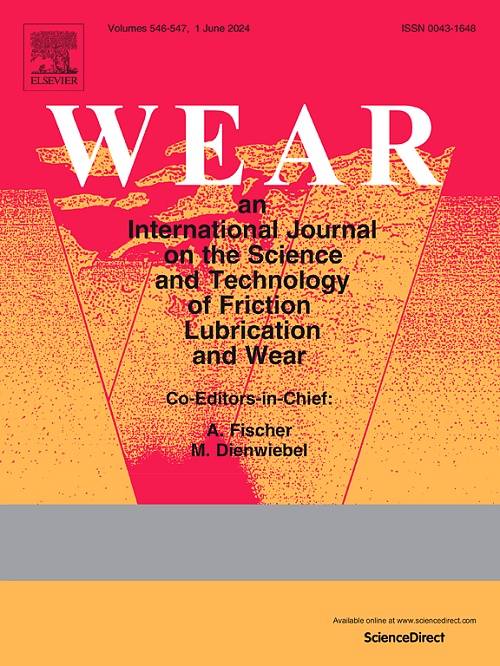Model-based optimization of micromilling AISI H11 tool steel: A comprehensive study of wear and its impact on surface quality
IF 6.1
1区 工程技术
Q1 ENGINEERING, MECHANICAL
引用次数: 0
Abstract
Micromilling is characterized by its ability to machine complex shapes from hardened tool steels while achieving superior surface quality. However, suitable process design is crucial to prevent critical tool loads that can accelerate tool wear, depending on the removal rate and cutting edge engagement. Various wear mechanisms can impair tool performance, particularly when machining difficult-to-cut materials. A deep understanding of process load, wear development, and its impact on surface quality is essential for optimizing machining performance and efficiency. This experimental study investigates the machinability of AISI H11 hot-work tool steel (50.9 HRC) using a micromilling process with PVD-TiAlN coated micro-end milling cutters d = 1 mm. A statistical design of experiments varied depth of cut, width of cut, and feed per tooth. Cutting forces were measured to analyze tool load, while surface topography and microhardness of the surface layer were evaluated. Tool wear was monitored, and empirical models focused on flank wear were developed. The results demonstrated that under finishing process conditions, especially with a depth of cut (ap) and feed per tooth (fz) below 15 μm, cutting force values were comparatively low (FR = 1.96 N). However, as tool wear progressed, increased ploughing effects raised specific cutting forces, resulting in an unsuitable process load. In contrast, highly productive process parameters (ap = 95 μm), (fz = 65 μm) resulted in higher cutting forces (up to 23.7 N), which, when increased by wear, led to overload-induced tool failure. Optimized settings promoted continuous abrasion as the dominant wear mechanism, significantly extending tool life. Tool tests revealed that wear-induced modifications impacted machining outcomes, improving surface roughness and increasing passive forces while enhancing microhardness. Overall, these findings highlight the effectiveness of model-based parameter optimization in enhancing micromilling performance and tool longevity.
基于模型的微铣削AISI H11工具钢优化:磨损及其对表面质量影响的综合研究
微铣削的特点是其加工复杂形状的能力,从淬火工具钢,同时实现卓越的表面质量。然而,适当的工艺设计对于防止可能加速刀具磨损的关键刀具负载至关重要,这取决于切削速率和切削刃接合。各种磨损机制会损害刀具性能,特别是在加工难切削材料时。深入了解加工负荷、磨损发展及其对表面质量的影响对于优化加工性能和效率至关重要。本实验研究了采用PVD-TiAlN涂层微立铣刀d = 1 mm进行微铣削加工AISI H11热加工工具钢(50.9 HRC)的可加工性。实验的统计设计改变了切割深度,切割宽度和每齿进给量。测量切削力以分析刀具载荷,同时评估表面形貌和表层显微硬度。对刀具磨损进行了监测,并建立了以刀腹磨损为重点的经验模型。结果表明,在精加工条件下,特别是在切削深度(ap)和每齿进给量(fz)小于15 μm时,切削力值相对较低(FR = 1.96 N)。然而,随着刀具磨损的进展,增加犁耕效应提高了特定的切削力,导致不合适的工艺负荷。相反,高生产工艺参数(ap = 95 μm), (fz = 65 μm)导致更高的切削力(高达23.7 N),当磨损增加时,导致过载导致刀具失效。优化的设置促进了连续磨损作为主要磨损机制,显着延长了刀具寿命。刀具测试表明,磨损引起的修改影响了加工结果,改善了表面粗糙度,增加了被动力,同时提高了显微硬度。总的来说,这些发现突出了基于模型的参数优化在提高微铣削性能和刀具寿命方面的有效性。
本文章由计算机程序翻译,如有差异,请以英文原文为准。
求助全文
约1分钟内获得全文
求助全文
来源期刊

Wear
工程技术-材料科学:综合
CiteScore
8.80
自引率
8.00%
发文量
280
审稿时长
47 days
期刊介绍:
Wear journal is dedicated to the advancement of basic and applied knowledge concerning the nature of wear of materials. Broadly, topics of interest range from development of fundamental understanding of the mechanisms of wear to innovative solutions to practical engineering problems. Authors of experimental studies are expected to comment on the repeatability of the data, and whenever possible, conduct multiple measurements under similar testing conditions. Further, Wear embraces the highest standards of professional ethics, and the detection of matching content, either in written or graphical form, from other publications by the current authors or by others, may result in rejection.
 求助内容:
求助内容: 应助结果提醒方式:
应助结果提醒方式:


